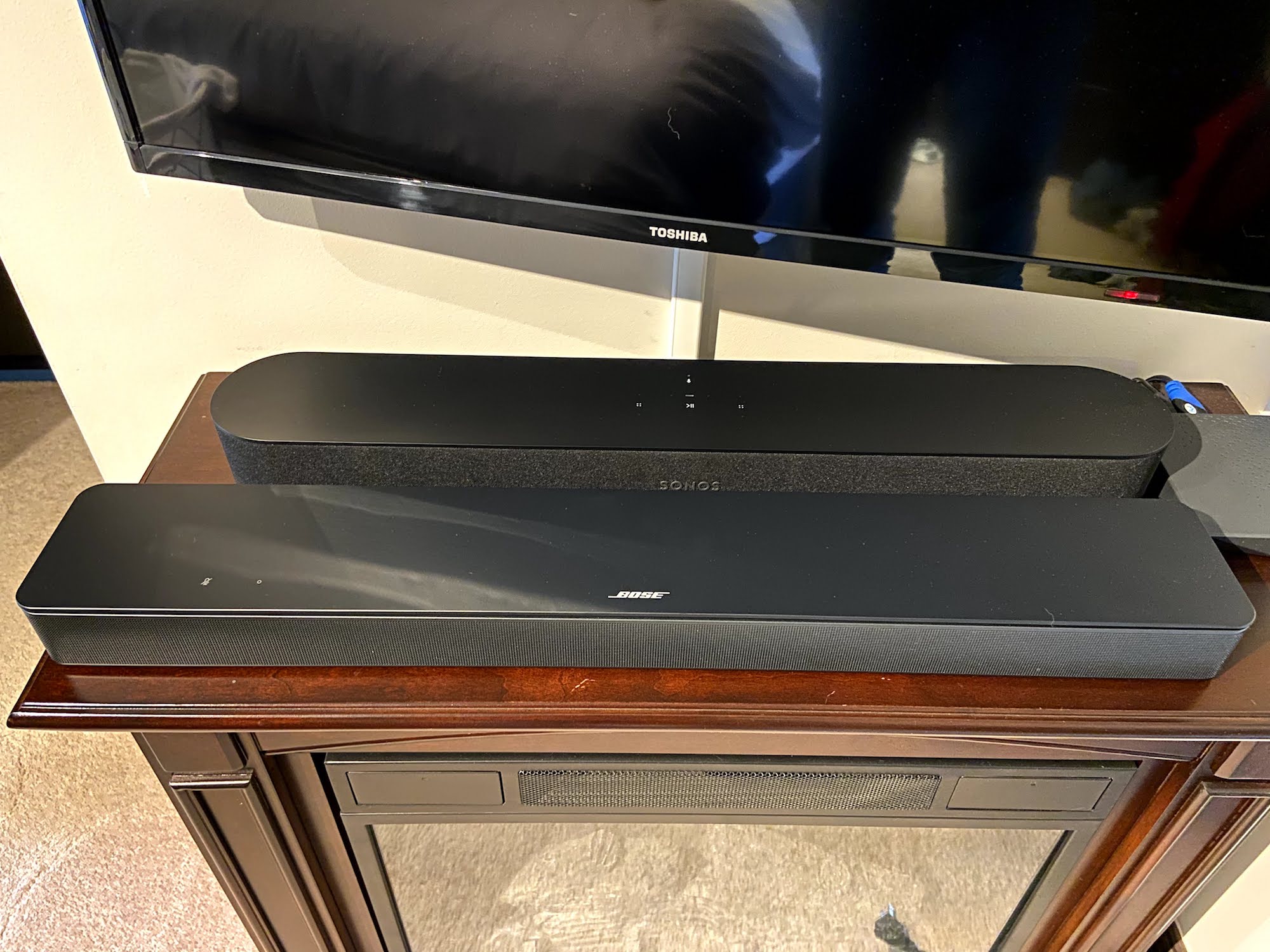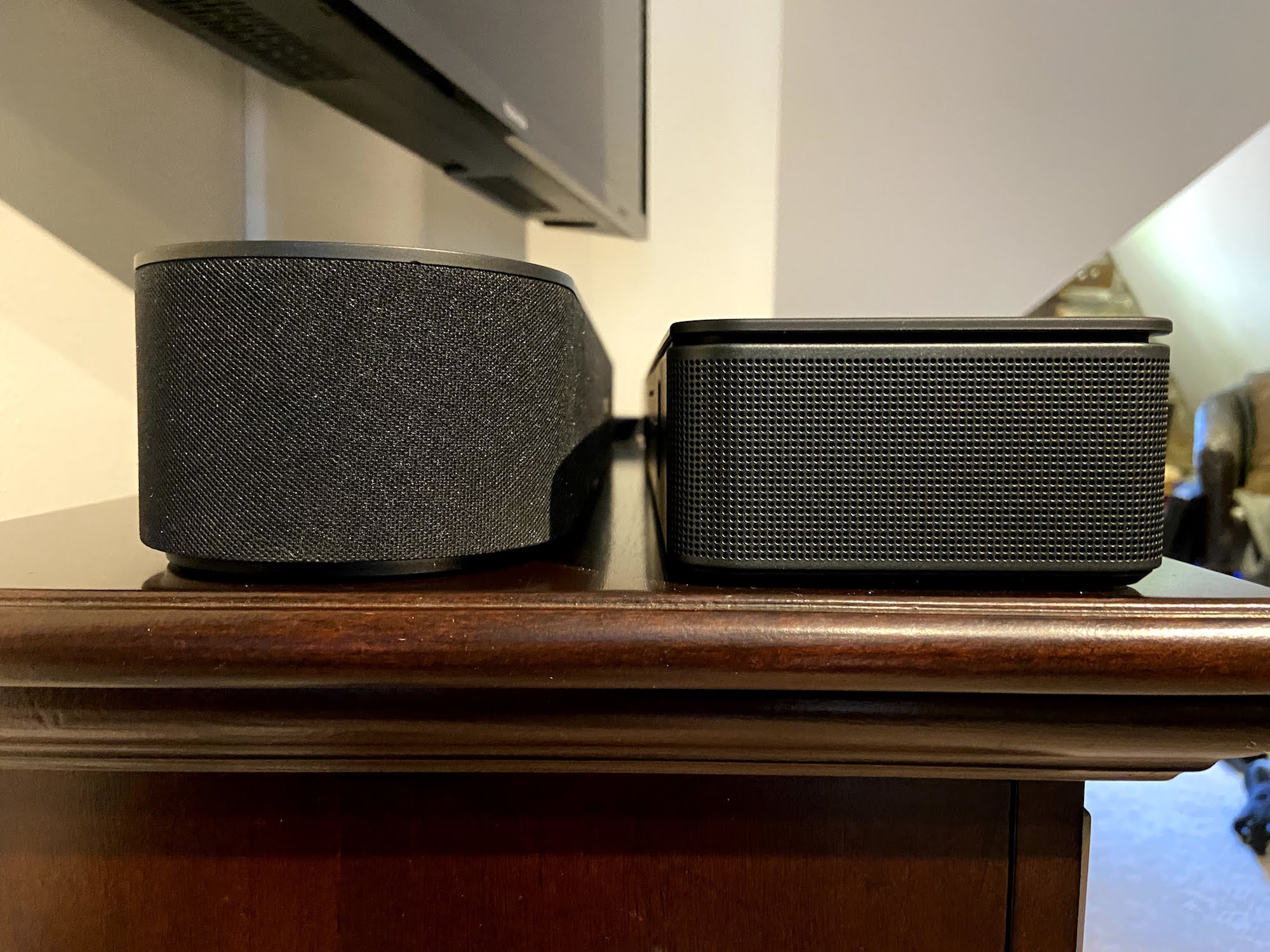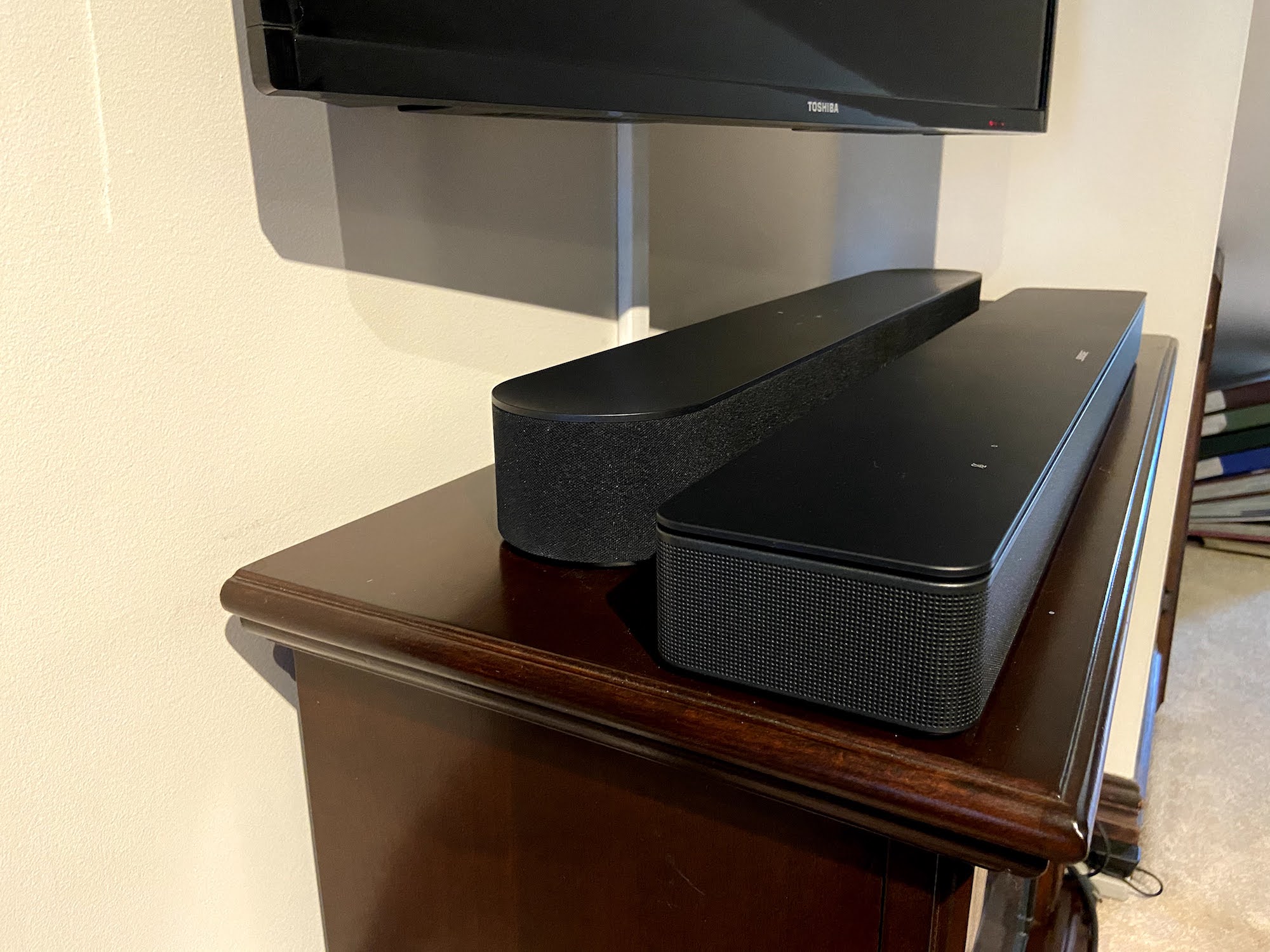- Expansive and rich sound
- Choice of Alexa or Google Assistant
- Private headphone listening
- AirPlay 2, Chromecast Built-in
- Expensive for a small soundbar
- Some music services not supported
Bose’s smart soundbar portfolio now includes speakers for almost every type of scenario, including folks who want a Dolby Atmos home theater replacement. But its smallest and least expensive model remains the $400 Smart Soundbar 300, yet it possesses many of the features of its more expensive siblings, the $550 Soundbar 500, the $800 Soundbar 700, and the flagship $900 Smart Soundbar 900.
It could be the perfect choice for those with smaller rooms (or simply smaller budgets). Is it right for you? Let’s check it out.
What’s in the box?
Packed in a mostly recyclable cardboard box (with a few foam inserts that you may have to throw away) you get the Smart Soundbar 300, a power cable, an optical cable, a remote control, and a quick-start guide.
Design

Bose’s soundbar design philosophy is one that I fully endorse: These speakers should be heard, not seen. With its all-matte-black enclosure and ultra-low-profile shape, the Smart Soundbar 300 is as close to invisible as it gets.
It’s going to look right at home sitting in front of virtually any TV I can think of.
At only 2.25 inches tall and 27.5 inches wide, it won’t obstruct the bottom of your screen, and (depending on the design of your TV) you might even be able to place it under the screen between the legs.
But it’s also elegant. With clean lines, a button-free exterior, and a wrap-around metal grille, it’s going to look right at home sitting in front of virtually any TV I can think of. The $449 Sonos Beam Gen 2 — the Bose’s closest competitor — is a little narrower, but it’s also a little taller.
In the top left corner, a small multi-color LED light strip gives you visual feedback about the speaker’s state. Two white bars indicate pause, a single blue bar signals Bluetooth, and a small red dot means mute. It would be cool if Bose used it to show volume level, but alas, no such luck.
If you want to wall-mount it, an optional $40 bracket is available.
Around the back, you’ll find the connection ports, which include one HDMI ARC, an optical input, an Ethernet port, an infrared extension port, and a subwoofer output. We’ll discuss how these can be used in a moment.
Setup and connections

As with the Soundbar 500 and 700, the Smart Soundbar 300 isn’t just a TV speaker — it’s also a wireless smart speaker that can be added to other Bose wireless speakers for a whole-home audio solution. Because of that, setting it up (and using its non-TV features) requires the Bose Music app (free for iOS and Android). These days, most people probably have a phone or tablet that can be used to run the app, but if you don’t, you may want to consider one of the many soundbar systems that do not rely on Wi-Fi or app-based control.
The Music app makes the setup effortless. In just a few minutes, it gets the soundbar connected to your wireless network and gives you the choice to configure the Soundbar 300 with either Amazon Alexa or Google Assistant, or you can simply skip this step (you can always do it later if you change your mind).
Connecting the speaker to your TV with the included optical cable has the advantage of not occupying one of your HDMI ports, which can be in short supply depending on your TV. Since the Soundbar 300 isn’t compatible with advanced audio formats like Dolby Atmos or DTS:X (which require HDMI ARC), an optical connection is really all you need.
Normally, using an optical connection means that you miss out on the kind of TV-control features that HDMI enables. But thanks to the Soundbar 300’s infrared emitter, you can still use Alexa or Google Assistant to operate TV functions without HDMI. That’s a neat trick and it’s something the Sonos Beam can’t do.
Curiously, Bose actually recommends using an HDMI cable, which it says is more reliable than using infrared. But it doesn’t include one in the box because it reckons most folks already have an extra HDMI cable lying around, whereas optical cables tend to be harder to come by.
The Bass port for wiring a subwoofer is proprietary, so there’s no way to use it with a sub from another company. But unless you’re a fan of wires, it makes more sense to extend the Soundbar 300’s low-end with Bose’s wireless subwoofers, the $400 Bass Module 500, and the $700 Bass Module 700. If you want to create a more immersive surround sound vibe, the soundbar is also compatible with the wireless $299 Bose Surround Speakers or $500 Bose Surround Speakers 700.
Whether you’re an Android or iOS user, streaming music from the Bose Music app over Wi-Fi is an option, though its capabilities as a music manager leaves something to be desired (more on that below). Instead, Apple users are going to be happiest using AirPlay 2 which gives any app on your phone or tablet a direct Wi-Fi connection to the speaker. Apple and Android users can also leverage Chromecast Built-in, a feature Bose added in February 2022. Sonos products do not currently support Chromecast.
Spotify subscribers can use the Spotify Connect feature to connect to the speaker from any Spotify app. There’s also Bluetooth on board, which is handy for ad-hoc music streaming without the need for a Wi-Fi connection.
Speaking of Bluetooth, the Soundbar 300 features the same Bose SimpleSync tech that we’ve tried on the more expensive Soundbar 500 and 700. SimpleSync lets you pair a set of Bose Bluetooth headphones or a Bluetooth speaker with the soundbar and control the volumes for the two devices independently. It may work with third-party headphones — I tried it with a set of Bowers and Wilkins PX5 headphones and it worked, albeit slightly out of sync. But your mileage may vary: Sony’s WH-1000XM4 weren’t recognized by the soundbar.
Sound quality

If you’re looking for room-filling sound, look no further. The Bose Smart Soundbar 300 delivers the goods, whether it’s bigger, better sound for movies and TV shows, or simply for listening to your favorite tunes.
By default, the speaker’s EQ is pleasingly neutral, providing a nice balance of frequencies that works well with a wide variety of music genres and TV content. But given that soundbars tend to be the tool of choice for those who want a simple home theater upgrade, it’s a good thing that you can dramatically increase the bass response using the Music app.
Don’t get me wrong, the Soundbar 300 can’t deliver the kind of bone-shaking bass that a dedicated subwoofer can provide, but in a smaller room, like a bedroom, it’s got more than enough oomph to bring even the biggest blockbusters to life.
Not that it needs to be confined to a small space — the soundbar can get really loud and manages to do so without any distortion.
It creates an immersive feeling that the Sonos Beam can’t quite match.
For vocal-heavy music or TV dialog, the soundbar gives a pristine, clear rendition. Higher frequencies operate freely and possess both structure and airiness — an unusual combo even in more expensive speakers.
I was especially taken by the Soundbar 300’s breadth of soundstage. Its angled full-range drivers do an impressive job of bouncing sound off of your side walls toward the viewing/listening zone, creating an immersive feeling that the Sonos Beam can’t quite match. The Beam feels warmer and possesses more resonance when it comes to string instruments like bass or cello, but it’s also a more contained sound. The Soundbar 300’s dispersion pattern feels far more open.
The dialog enhancement mode is essentially a one-click EQ adjustment that rebalances higher frequencies to the foreground while forcing other bands to take a back seat. It’s not a replacement for something as specific as the Zvox AV157 TV Speaker, but it goes a long way to making muddied speech easier to make out.
Multiroom audio and music sources
The Bose Music app provides an easy way to manage multiple Bose wireless speakers around your home, including the ability to group them for joint or separate playback. It’s not perfect — you can’t stereo pair speakers or use them as surrounds to enhance a soundbar like the 300 — but for most folks, it offers very good control.
But that control doesn’t extend very far into music streaming. The app supports a decent selection of music services including Apple Music, Amazon Music, Deezer, Spotify, Pandora, iHeartRadio, TuneIn, and SiriusXM, but there’s no consistency. Some services are searchable, some aren’t and each has its own interface. There’s no way to build playlists using the app, so you’re reliant on each service’s own tools. You can save playlists, albums, and tracks as presets, but the app only gives you six presets to work with.
Sonos’ system isn’t just better, it’s orders of magnitude better, with universal search, unlimited favorites, multi-source playlists, and support for every streaming service under the sun.
Remote control

The Smart Soundbar 300 comes with a small and simple infrared remote. It covers the basics: Volume, mute, play/pause, power, and source selection (music, TV, Bluetooth). The rubberized surface and curved back make it easy to hold and use.
The only unusual aspect of this remote is the ability to use the Music app to synchronize the power button’s function with your TV and/or cable box. When you do, pressing the power button turns on/off the soundbar and these other two devices.
Voice assistants

The Soundbar 300 lets you pick Alexa or Google Assistant as your voice A.I. and you can change your mind at any time, but just like on a Sonos smart speaker, you can’t run both simultaneously.
Regardless of which A.I. you pick, the soundbar’s mics do a great job of picking up wake words and commands.
The one you pick will determine which features you get to use — here’s a great look at the advantages of each system. But one key consideration for those who want to use their voice to control their tunes: The service you want to control has to be supported by the Bose Music app as well as your chosen voice assistant, or it won’t work.

Regardless of which A.I. you pick, the soundbar’s mics do a great job of picking up wake words and commands, even from across the room — no shouting needed. A tap on the mic button gives you complete privacy. I especially like the fact that the LED light strip responds to let you know your wake word was heard. The Sonos Beam can confirm wake words too, but it uses an audio chirp instead, which I find more intrusive.
Those who set up Alexa on the soundbar can take advantage of Bose’s Voice4Video technology which extends Alexa’s command and control to your TV and your cable box — even if those devices aren’t directly compatible with Alexa. Once configured, you can ask Alexa to turn on the TV, and even switch to a specific channel.
I found this feature to be a bit hit and miss. Basic commands like “Alexa, turn on the TV” worked flawlessly, but channel changes proved more inconsistent. Sometimes when I asked Alexa to switch to channel 33, I’d see “333” show up on the screen. At other times, the channel request would be accurate, but the channel change itself wasn’t executed. And sometimes, it simply worked.
It’s possible these glitches were related to my specific TV and cable box combo, but given that I was using HDMI, not optical, I would have expected more consistency.
Our take
The Bose Smart Soundbar 300 is a superb choice for music and movies in small-to-medium-sized rooms, with an expansive sound and some really innovative extra features.
Is there a better alternative?
If you want to build a whole-home audio system, the $449 Sonos Beam Gen 2 is a better choice. It sounds great — with or without its Dolby Atmos capabilities — and its software platform remains the very best in the business for those who want total control over their music and their speakers.
But, if what you’re really after is a soundbar that can drastically improve your TV’s audio performance for movies and shows, and do an equally good job with your favorite music, I think the Bose Smart Soundbar 300 sounds better.
How long will it last?
The Bose Smart Soundbar 300 comes with a one-year warranty. Bose has an excellent reputation for building quality products and I expect the Soundbar 300 will last as long as you need it to.
Should you buy it?
Yes. The Bose Smart Soundbar 300 may be expensive compared to many other TV speakers, but its sound quality, customization, extra features, voice control, and expandability make it an investment you won’t regret.








